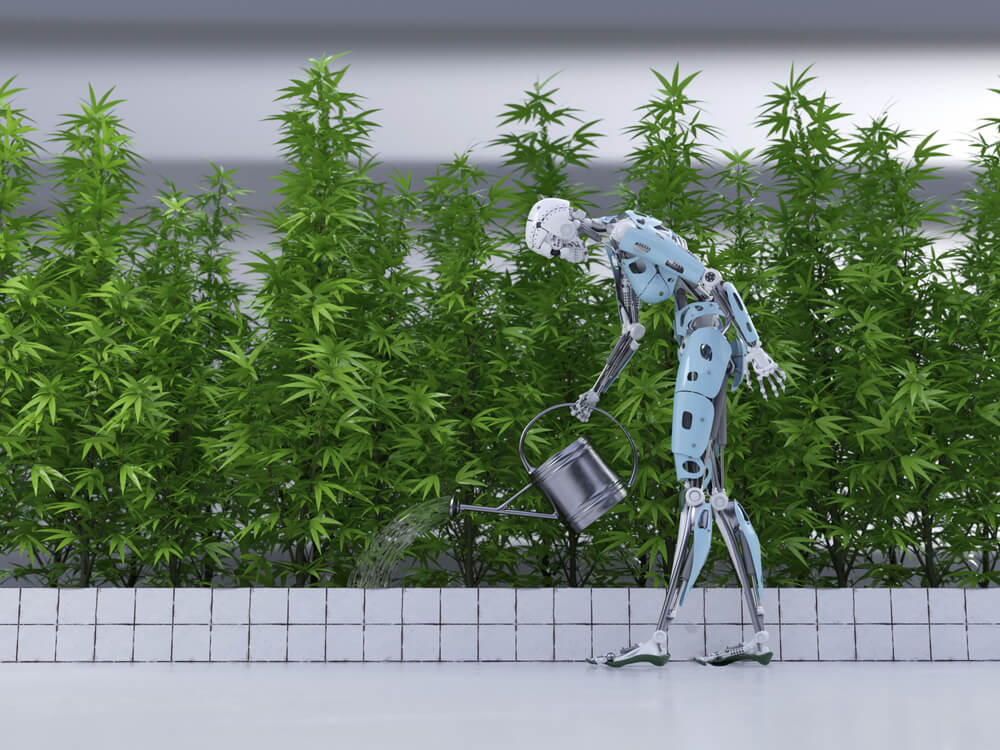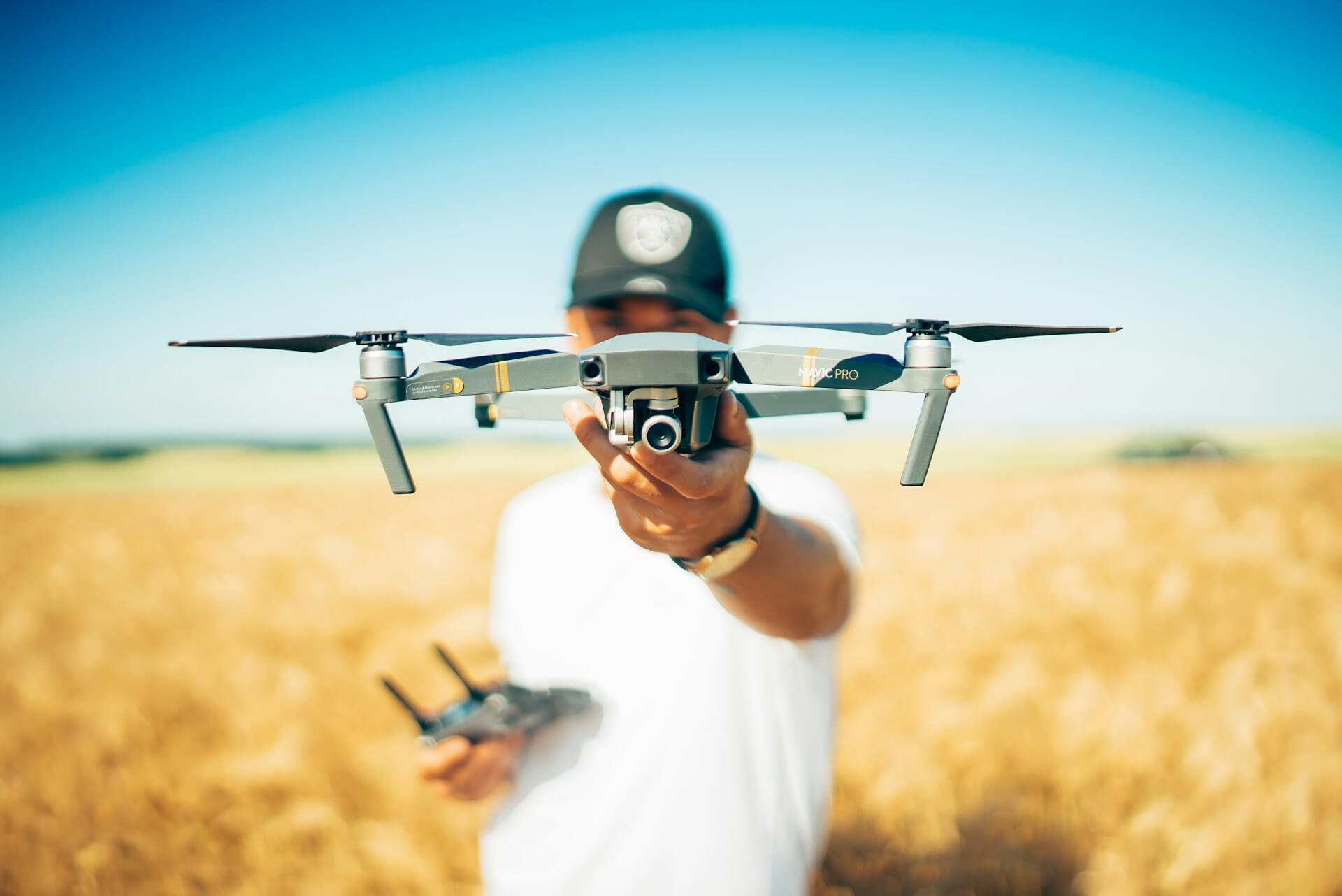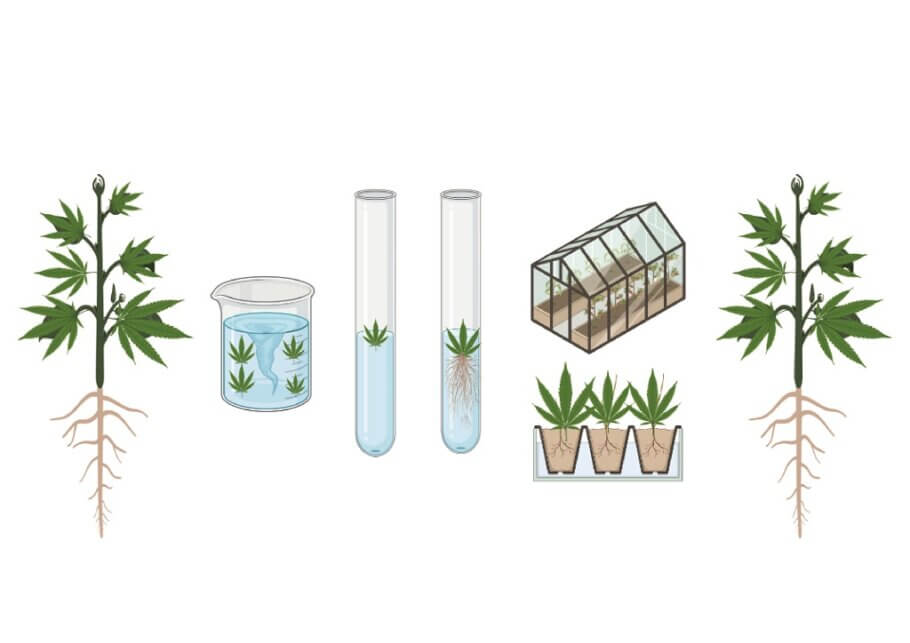Have you ever wondered what it will be like to grow cannabis in, let’s say, 20-30 years? What new technologies and techniques will be available by then? What will marijuana strains look like in a few decades? Will we be growing genetically edited plants? Today we want to invite you to participate in a kind of cannabis uchrony where we will try to imagine what our favorite hobby will be like in the relatively near future, say around the year 2050.
So buckle up and get ready for a journey into the future of cannabis cultivation. We are sure that the technologies that are recently emerging will play a key role in this activity—and maybe some more that we didn’t even suspect! Will you join us?

Cannabis cultivation and technology
If one thing has become clear to us in recent years, it is that technology is revolutionizing cannabis cultivation by integrating artificial intelligence, advanced sensors, and bioengineering to improve the production process. Indeed, and something that is becoming less and less rare to see in many crops, the use of connected sensors allows for exhaustive monitoring of light, humidity, pH, and nutrients, thus optimizing every aspect of the plants’ development.
Furthermore, the use of drones in greenhouses or cultivation areas facilitates detailed inspections and the early detection of problems in large areas, while applying bioengineering to marijuana cultivation allows the development of varieties with personalized cannabinoid profiles and greater resistance to pests. Finally, hydroponic and automated irrigation systems increase sustainability by reducing water and nutrient consumption, greatly optimizing results, especially for professional crops.
All of these technologies and applications are already in use in the cannabis sector today, although it is clear that over the next few years, they will continue to evolve in the same way that we have seen, for example, with LED grow lights. Not only that, we are also convinced that new technologies with interesting applications in our field will soon appear…let’s take a look at some of them!
The future of cannabis cultivation
The future of cannabis cultivation is set for radical change thanks to technology, which allows for improvements in every stage of the process, from plant genetics to greenhouse management and even post-production processes. As we have said, the integration of tools such as artificial intelligence, bioengineering, and automated monitoring systems seeks to increase production efficiency while achieving greater sustainability, something that we fear will be of great importance in the future.
Well, let’s now look at some of these future technologies that could transform our activity into something completely different, more efficient, and with better results for the grower. Thanks to technological advances and a more scientific approach to the activity, cannabis cultivation could be transformed in 20 or 30 years.

Vertical farming and cultivation systems
If there’s one thing we’ve learned over the past few years, it’s that we need to know how to use the water we have available almost as if it were a treasure. Long periods of drought can cause major problems in the field of agriculture, and cannabis cultivation is no exception. That being the case, it’s not surprising to think that aspects such as vertical farming and the use of advanced hydroponic systems will help us optimize the space and resources available, allowing for high production of high-quality buds in practically any type of environment, even in an urban one.
Micropropagation and tissue culture
Micropropagation, or tissue culture, is revolutionizing cannabis cultivation by allowing plants to be cloned in controlled environments, accelerating the production of genetically identical and healthy plants. This method, which uses cells from a mother plant to generate new plants, minimizes risks such as diseases and contaminants common in traditional cultivation and which are transmitted from the mother plant to clone, optimizing the genetic homogeneity and quality of each plant.
In this way, in the future micropropagation will allow for large-scale production with high purity standards, ensuring consistency in cannabinoids and terpenes, which is key for both medicinal and commercial applications. We do not doubt that in a few years, we will see new techniques and means of micropropagation that will make this activity much more common than it is today, especially in the professional sector.

Tissue Culture for Cannabis
In vitro plant propagation or micropropagation is a technique that has advanced considerably in recent years. Today we’d like to present a brief introduction to this highly specialised method of cultivation, which, as you will see, opens up many possibilities for cannabis growers.
Artificial Intelligence and Big Data
Artificial intelligence, which is so much on everyone’s lips these days, will probably be a tool that we will be able to count on in countless aspects of our lives, and cannabis cultivation will be no exception. In combination with different precision sensors capable of measuring aspects such as temperature, humidity, or ppm of CO2 present in the environment, it will allow us not only to monitor the development of each plant but also to adjust parameters such as light intensity, the presence of nutrients and humidity in the environment or substrate in real-time and in an automated manner, thus allowing us to maximize production and the quality of the final product.
These precision cultivation technologies, driven by Big Data and machine learning, will also allow us to create customized conditions for each plant, significantly improving the quantity and quality of the flowers obtained. In addition, they can be applied to other aspects of our activity, as we can already see today in measurement and analysis devices such as the NeoSpectra cannabinoid and terpene analyzer. Yes, with a simple image of a plant, we will probably be able to know many things about it: nutrient deficiencies or excesses, pests or diseases, and even its cannabinoid and terpene content, and we will also be able to correct potential problems in real-time and automatically.

Robotic cultivation systems
In relation to the previous point, autonomous cultivation robotic systems connected to databases with artificial intelligence could take care of the daily maintenance of the crop, reducing human intervention, the risk of pests or nutritional problems, and labor costs. In addition, augmented and virtual reality techniques will allow growers to monitor and manage crops remotely in real time, facilitating administration at a global level, something that will be very important for large companies producing buds or extracting resin.
Biotechnology and genetic editing
As if all this were not enough, advanced genetics are expected to allow the development of personalized varieties, adapted to meet specific needs in terms of the optimization of cannabinoid and terpene profiles, making them ideal for medical treatments of a wide variety. This would be complemented by the use of genetic editing techniques such as CRISPR, which are used to modify plant properties, increasing their resistance to diseases and reducing the use of pest control products.
In the future, cannabis cultivation could include innovations such as advanced bioengineering to design plants that produce higher amounts of specific cannabinoids or even new therapeutic molecules. This is certainly one of the fields where we will see the most changes in the future, and we may even end up growing exclusively triploid cannabis varieties, something we can already see using traditional genetic selection.

Is CRISPR gene editing the future of cannabis?
In the last decade, we have all heard about GMOs and how the food industry has been transformed to favour genetically modified varieties. But have you heard of CRISPR/Cas9? This gene editing technique has already landed in the cannabis industry and could revolutionise the market in the coming years. In this article we tell you everything there is to know about it.
What will be the next resin extraction method to dominate the market? Nowadays it is not uncommon to see all kinds of solvent-based and solvent-free extractions, from the most traditional hashish to supercritical CO2 extractions or concentrates such as Rosin Hash, Shatter, or Piatella hashish. What if we told you that some companies have been growing cannabis trichomes in bioreactors for years? Yes, you read that right, the use of these devices to produce trichomes is a fact of life today, so it is not crazy to think that, in the future, we will be able to choose what type of concentrate we want, with what proportions of cannabinoids and terpenes, and grow them directly in bioreactors, without the need to grow the plant. Crazy, don’t you think?
Nanotechnology and cannabis cultivation
Another emerging technology that may well become standard will be the use of nanotechnology. Can you imagine being able to use nano nutrients to feed your plants? These nutrients, which are usually in the form of nanoparticles, allow for faster and more effective absorption into the roots and leaves, promoting more vigorous growth and a higher yield of cannabinoids and terpenes. In addition, by using smaller doses of fertilizers, the environmental impact and the risk of residue accumulation in the soil are reduced. Nanonutrient technology allows for precise control of nutrition at each stage of cannabis development, increasing crop efficiency and promoting plant health.
Looking at these applications in nutrition, it seems possible that in the future we might even have the opportunity to use nanotechnology to combat some of the most common pests in our plants. Can you imagine having a small army of nanorobots capable of eradicating a red spider infestation in just a few hours? Sounds good, doesn’t it?
3D printing
No, we probably won’t be able to print fantastic, aromatic buds for our enjoyment, but what will surely start to be produced from 3D printers are devices or instruments used in cultivation, such as lighting modules, pots with optimized geometries or irrigation systems, leaving a much smaller environmental footprint and offering the possibility of creating custom designs for each growing space, something of great help to the grower when planning their installation.
In addition, 3D printing enables the manufacturing of spare parts for cultivation equipment, improving sustainability and reducing costs. In the future, it could even enable the production of micropropagation matrices and containers for tissue culture, accelerating innovation in cloning and propagation techniques.

Clean and renewable energy
Let’s not kid ourselves, indoor cultivation with artificial light lamps would not be the most sustainable agricultural activity, especially when carried out in countries with a climate suitable for outdoor cultivation. Therefore, the development of new and more efficient sources of sustainable energy will be of great importance for the evolution of indoor cultivation, reducing its environmental footprint and, with a bit of luck, reducing the cost of electricity.
Legality of cannabis
Last but not least, we have the question of the legality of the plant. With more uniform legislation, for example at the European level, consumers will have access to cannabis that is completely transparent in its traceability and adapted to a highly technological and regulated global market. Strict controls and blockchain traceability can also be implemented to guarantee the quality, purity, and legal origin of cannabis, which will be a key pillar in an increasingly regulated and professionalized global market.
As you can see, there are many changes awaiting our sector in the coming decades, and these are just some of the ones that could occur. And you, how do you think our activity will evolve over the years? What are your predictions for cannabis cultivation in the medium and long term? Share them with all of us in the comments section, we will be happy to read them.
Happy harvests!
Source link
#Cannabis #cultivation #future #Alchimia #Grow #Shop